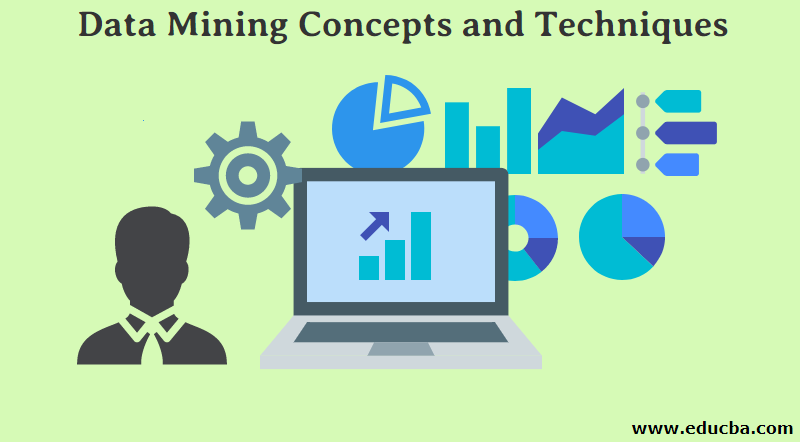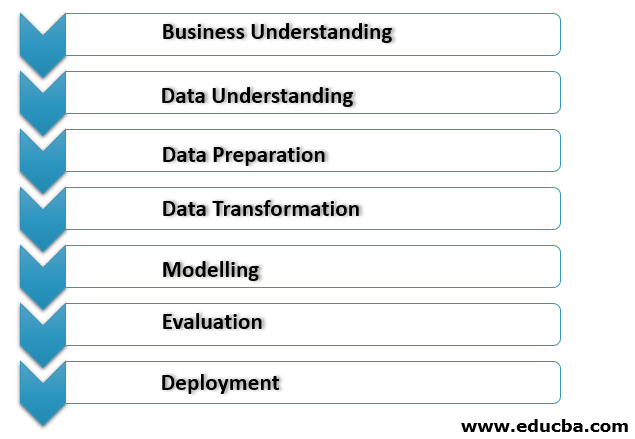Updated March 21, 2023
Introduction to Data Mining Concepts and Techniques
The following article provides an outline for Data Mining Concepts and Techniques. Data mining is a feature of the conversion of data into some knowledgeable information. This refers to getting some new information by looking into a large amount of data available. Using various techniques and tools, one can predict the required information from the data only if the procedure followed is correct. This helps various industries extract some required information for future analysis by recognizing some patterns in the existing data in databases, data warehouses, etc.
Types of Data in Data Mining
Following are the types of data on which data mining can be performed:
- Relational databases
- Data warehouses
- Advanced DB and information repositories
- Object-oriented and object-relational databases
- Transactional and Spatial databases
- Heterogeneous and legacy databases
- Multimedia and streaming database
- Text databases
- Text mining and Web mining
Data Mining Process
Below are the points for the Data mining process:
1. Business Understanding
This is the first phase of the data mining implementation process, where all the needs and the client’s business objectives are clearly understood. Proper data mining goals are set, keeping in view the business’s current scenario and other factors such as resources, assumptions, constraints. A proper data mining plan should be in detail and must fulfill our business and data mining goals.
2. Data Understanding
This phase act as a sanity check on the data that has been collected from various resources for data mining processes. First, all the data from the different sources are organized related to the organization’s business scenario, which can be in the diverse database, flat files, etc. The collected data is checked that they are matching properly as they can be unrelatable.
Sometimes metadata also needs to be checked to reduce the errors in the data mining processes. Various data mining queries are used to analyse correct data, and based on the results; data quality can be checked. It also helps to examine if any data is missing or not.
3. Data Preparation
This process consumes the maximum time of the project. This face includes a process called data cleaning to clean the data that has been collected during the data understanding process. The data cleaning process is used to clean the data to exclude improper noisy data for the data with missing values.
4. Data Transformation
Data transformation operations are performed in the next state, which is used to change the data to make it useful for the data mining implementation process. Here transformation such as aggregation, generalizations, normalization or attribute construction makes the data ready for the data modelling process.
5. Modelling
This is the phase in data mining, where the proper technique is used to determine data patterns. The various scenarios have to be created to check the quality and validity of this model and determine whether the goals defined in the business understanding process are being met after implementing those techniques. The pattern that has been found in this process is further evaluated and is sent for deployment to the business operations team so that it can help to improve organizations’ business policy.
6. Evaluation
In this phase, the proper evaluation of the data mining discoveries is made to give it a go or no go to implement the business processes. A fair comparison is made with the discoveries. The existing business operations plan to evaluate the change for the information properly found needs to be added to the current business operations.
7. Deployment
In this phase, the information that has been concluded using data mining processes are transformed train understandable form for non-technical stakeholders. For this process, a proper deployment plan that includes shipping, maintenance and monitoring of the information found is created. In this way, the proper project report is created along with the experiences and the lessons learned during the process to hand over our data mining discoveries to the business operations team.
Hence this process helps to improve the business policy of an organization.
Data Mining Techniques
Below techniques and technologies can help to apply data mining features in their most efficient manner:
1. Track the Patterns
Recognizing the patterns in your dataset is one of the basic techniques in data mining. The data is observed at regular intervals for recognizing some aberration. For example, it can be seen if a particular person travels around different countries, then that person will require to book tickets regularly. Thus a special credit card can be offered.
2. Classification
It is one of the complex techniques for data mining, where we need to make various discernable categories using various attributes in the existing data. These categories help to reach various conclusions for our future use. For example, while analyzing the traffic data in the city, the area’s traffic can be classified under low, medium and heavy. This will help the travelers to predict the traffic before time.
3. Association
This technique is similar to the pattern tracking technique, but it is related to the dependently linked variables. That means the pattern for the corresponding data is found that is linked to the existing data. Event-related to the other event is tracked, and the particular ways are found in that data. For example, file tracking data for the traffic in a particular City can also track the most visited places in a city. This can also help to track famous places to be visited in the City.
4. Outlier Detection
This technique is related to the extraction of anomalies in the pattern of data. For example, the sale of a mall makes a good profit over the 11 months of the year, but in the last month, the sales dropped that much to face loss. In these cases, we need to find out the factor that reduced the sales to avoid it next time. The technique of finding such a distraction in the regular pattern is part of the Outlier detection technique.
5. Clustering
This technique is similar to classification; only the difference lies in that it picks the group of data that have some similarities put them in a single group. For example, clustering different audiences of a cinema based on frequency, how often they come for shows, which timing they reach for most often and which genre of movie they come for.
6. Regression
This technique helps to draw the relationship between the 2 variables on which an analysis could depend upon. Here we try to determine the pattern of change in the variable by fixing the other dependent variables. For example, if we need to find out how to sell a product in a mall depending on its availability, season, demand, etc. This can lead the owner to fix the price for selling it.
7. Prediction
The most important feature of data mining is reducing future risks and increasing the organization’s profit by studying the existing and historical patterns for sales and credit risks. Here this type of technology helps us make future decisions depending on the way found in historical and present data and keeping market change and threats in mind. This technique is most helpful for data mining.
Data Mining Tools
One doesn’t need the particular latest technologies for performing data mining. It can be done using the latest database systems and simple tools available in any organization. Also, one can create its own tool when the appropriate device is missing. The most popular tool is widely used in the industry are given below:
1. R-Language
This is an open-source tool that is used for statistical computing and graphics. This tool helps in effective data handling and storage facility ad these all features are because of the below techniques:
- Statistical
- Classical statistical tests
- Time-series analysis
- Classification
- Graphical Techniques
2. Oracle Data Mining
This tool is popularly known as ODM; it is a part of the Oracle Advanced Analytics Database. This tool helps to analyze data in data warehouses and generates detailed insights that help make predictions. These things help to study customer behaviour; products demand ad thus help in increments of selling opportunities.
Challenges being faced in the implementation of Data mine:
- Skilled experts are needed to make complex data mining queries.
- Present models may not fit in the future state’s databases .may not fit future conditions.
- Difficulties faced in managing large databases.
- It may be needed to modify business practices to use information that has been uncovered.
- Heterogeneous databases and information coming globally can result in complex integrated information.
- Data mining has a prerequisite that data must be diverse in nature. Otherwise, results can be inaccurate.
Conclusion – Data Mining Concepts and Techniques
In this article data mining concepts and techniques, Data mining is a way for tracking past data and make future analyses using it. It is the same as extracting the information required for analysis from last-date assets that are already present in the databases. Data mining can be done on various types of databases like spatial data basis, RDBMS, data warehouses, multiple and legacy databases, etc. The Whole mining process includes business understanding, Data Understanding, Data Preparation, Modelling, Evolution, Deployment.
Various data mining techniques are available to make data mining work efficiently, such as classification, regression association, etc. Usage depends on the scenario. The most useful data mining tools are R-language and Oracle Data. The main disadvantage of data mining is the difficulties in training experts to operate that analytics software. There are diverse industries that use data mining for their analysis purpose, such as banking, manufacturing, supermarkets, retail service providers, etc.
Recommended Articles
This is a guide to Data Mining Concepts and Techniques. Here we discuss the data mining process, techniques, and tools in Data Mining. You can also go through our other related articles to learn more-



